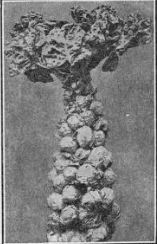Brussels Sprouts (Brassica Oleracea, Var. Gemmifera)
Description
This section is from the book "Vegetable Gardening", by Ralph L. Watts. Also available from Amazon: Vegetable Gardening.
Brussels Sprouts (Brassica Oleracea, Var. Gemmifera)
331. Character
Brussels sprouts is one of the many variations of cabbage. Instead of a single head at the top of the stem, a large bud or miniature head is borne in the axil of each leaf, so that little heads are scattered all along the tall stem, which is crowned with a cluster of loose leaves. (Figure 65).
The solid little heads or "sprouts" as they are known, from 1 to 2 inches in diameter, are cooked and pickled in the same manner as cauliflower. They are regarded as fully as tender and delicious. This vegetable is most appreciated during fall and winter months.
332. Importance
Brussels sprouts find ready sale on the large city markets, and should be grown much more extensively. Many Americans are not familiar with the excellent quality of this vegetable. The demand for it in the large cities of this country is due mainly to the foreign population.

Fig. 65. Brussels Sprouts.
333. Culture
The culture is practically the same as for cabbage. Well-bred seed is exceedingly important. Sowings may be made under glass the first of February, transplanting the seedlings to the cold frame in March and to the open ground in April. The plants are slightly less hardy than cabbage. For the late crop, sowings should be made in the open during May, the transplanting occurring six or seven weeks later. Successional sowings may also be made. A deep, rich, moist soil is required for the best results. The plants should be spaced about 18 inches apart in the row, and there should be sufficient space between rows to cultivate with a horse. Nitrate of soda can be used to advantage in addition to stable manure or complete fertilizer.
The miniature heads form on the late plants toward the end of the summer, when the leaves along the stalks are cut off to favor the development of the "sprouts." These improve in quality by frost, and therefore "sprouts" are most in demand during the late fall, although marketed for probably two months before the occurrence of frost. The plants may be lifted and stored during the winter by the methods used for cabbage. The crop is usually marketed in berry baskets, and sometimes in two and four-quart baskets. The leading varieties sold by American seedsmen are Long Island Improved, Burpee Danish Prize and Dreer Select Matchless.
Continue to:
- prev: Broccoli (Brassica Oleracea, Var. Botrytis)
- Table of Contents
- next: Cabbage (Brassica Oleracea, Var. Capitata)
Tags
plants, crops, gardening, cultivated, harvesting, food ,greenhouses, fertiliser, vegitables
